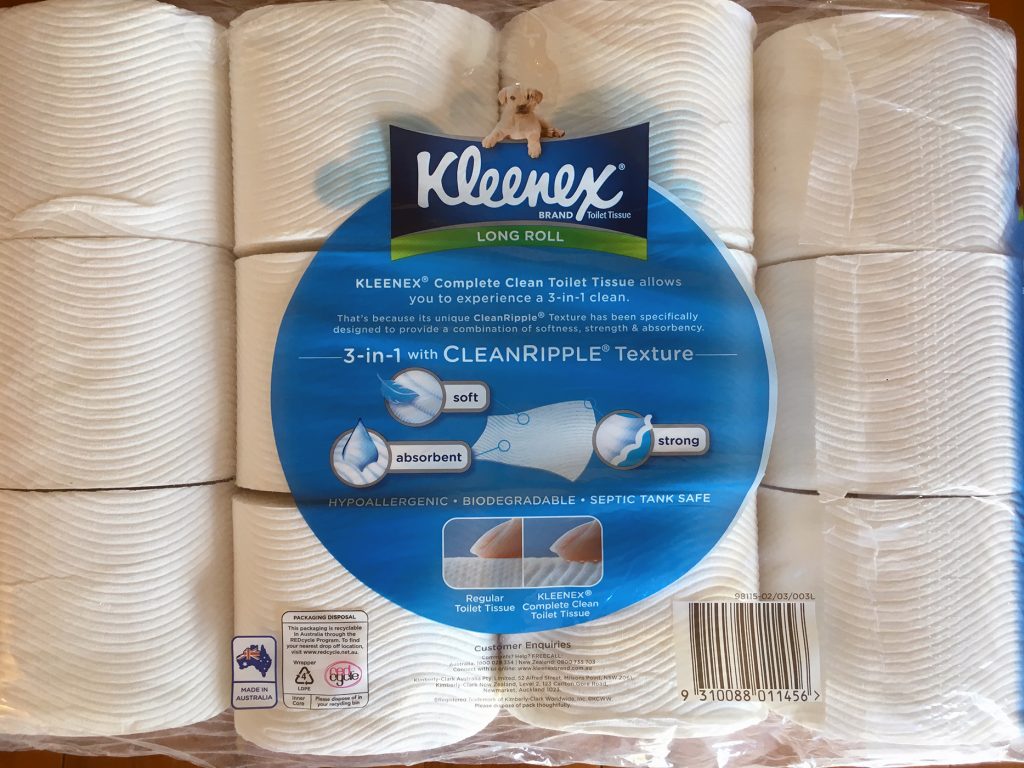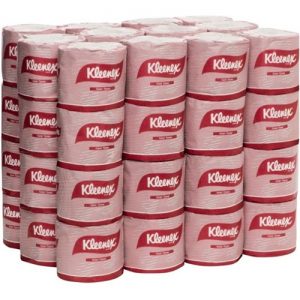I was out shopping at the supermarket on Saturday with my daughters. They both love pushing the trolley or being in charge of getting the items off the shelf. I’m not normally a ‘bulk-buy’ kind of person (I’m usually worried about the 10 kg bag or rice getting weevils!) but when it comes to toilet paper, I make an exception. So, we pick up a large package of toilet paper, and yes, I did seize this as a I’m-a-maths-teacher-so-I’m-going-to-make-my-child-do-maths moment.
“So, Penny, how many rolls are in the pack?”
She holds the pack, then looks at the rolls through the clear plastic packaging and starts to use her pointer and index finger to count by twos across the top row saying 2, 4. Then, as she starts to repeat the count in the second row, she starts with 6 but then finds it difficult to continue the count as there is a large blue circle on the plastic covering parts of the rolls…
At this moment, I could have stepped in and helped continue the count, but it’s important to notice the beginnings of ‘productive struggle1’ and let them, for want of a better word, fester. My mind at that moment was also making links to what I know of young children’s development of additive and multiplicative strategies2, where tasks with concealed items are more difficult and require students to be able to make mental images of the structure of number.
Penny has good number sense, and if this was a question on paper or a straight “let’s count by twos” tasks, I have no doubt she would be successful. But the ability to apply these known strategies in unfamiliar situation (or real-life situations as this) where the numerical values are not immediately obvious, for a moment, had her thinking.
She attempted to keep moving her fingers across the row to work out ‘how many twos’ were in this row. She physically moved her head back slightly to then look at the whole package (to me this was observing the overall structure of the package and noting that all the rows were ‘the same’). Quickly she realised there must be two groups of two in that row, evidenced by her starting the count again at the top left and quickly counting “2, 4, 6, 8” then moving to the last row and continuing the count “10, 12.”
“12 rolls.”
I could have left the questioning there, seeing that Penny had found the ‘answer’ but that’s not the point of mathematics. And that’s not the point of teaching. Our aim as teachers is to discover what students are able to do, what are the most efficient and flexible strategies they are using, and foster those skills. Often students don’t know this, they use comfortable strategies to get a solution because they think that’s what the end goal is – the answer.
However, what students understand about how numbers work, how aspects of mathematics connect together, finding patterns and making connections, leads them to be able to generalise. This, this is what students should know we are looking for, and this is why I asked a further question.
“Is there another way you could work out how many rolls?”
Penny went on to notice the columns of three going down. Saying “there’s three there, so three, six, nine, 12, because 4 threes are 12.” Just by using an extending prompt, Penny was able to share more than her knowledge of counting by twos and more than an answer of 12. This response shows her ability to flexibly see the array structure as both the count by twos (additive) and 4 threes (multiplicative).
Making it clear to students as to when we are looking for an accurate calculation (product), compared to when we are looking for multiple ways (process) of looking at numbers or their structure is important. In the maths classroom, just as in the real world, there are times when we need an exact answer and may use a more comfortable, and possibly more simplistic, way of solving the task. For example, checking that you’ve been charged the correct amount on a bill. Compared to times when we want an estimate or need options of ways to solve the problem, where knowing how numbers can be partitioned3 or regrouped helps. For example, organising seating arrangements for a large party.
I shared this supermarket shopping story about my daughter to highlight the reasoning behind allowing students to develop strategies and allowing students time to share what they know and how they know it. Our brief discussion over toilet paper allowed me to hear and see Penny’s thinking. There’s no point in knowing mathematics if you can’t communicate your understanding or describe it to others. I often hear “If they just knew their times tables” by some in educational circles and within the further community. But what is it about their ‘times tables’ that people are actually wanting students to know?
As an adult:
- I’ve never been speed-tested on my times tables
- I’ve never had to recite them in order
- I didn’t have to know them at-pace to solve more complex problems in higher education assessments
What I did need to know was:
- how to split a bill using division and related multiplication facts
- how to use halving as an opposite operation to doubling
- how to use knowledge of factors to find equivalent fractions when baking
- how to use division and the unitary method to solve percentage sale problems.
So, I think when people say “if they just knew their times tables” what they should realise is that students need a flexible view of factors and multiples to apply in a variety of related and new situations – they need multiplicative thinking. Making this distinction between ‘rote knowledge of times tables’ and ‘deep understanding of multiplicative thinking’ changes the value placed on the knowledge itself and how it is communicated by teachers and learned by students. Having these facts and understanding readily available (automaticity) is part of the goal, but it not the goal within itself.
Does it matter if they don’t know what 8 x 7 is straight way? No
Does it matter if they don’t know a way to work it out? Yes
For Penny, at her stage of learning, counting by twos was probably a far faster strategy than taking the time to work out 4 threes. But her knowing that it could be worked out using 4 threes sets her up for success. Especially when the numbers get larger, say in the case where there are 36 or more toilet rolls. In this case when there are multiple layers, counting by twos becomes inefficient and much more complex when there are elements that are hidden. This creates a need to know other strategies, not just know facts.
References
1 Productive struggle https://www.teachermagazine.com.au/articles/learner-persistence-the-productive-struggle
2 Multiplicative thinking http://www.education.vic.gov.au/Documents/school/teachers/teachingresources/discipline/maths/assessment/keyideasstrat.ppt
3 Partitioning https://www.education.vic.gov.au/Documents/school/teachers/teachingresources/discipline/maths/assessment/partitioning.pdf
Image of Kleenex toilet paper stack https://www.officemax.co.nz/images/ProductImages/500/2604515.jpg
Note: This blog was in no way sponsored by Kleenex nor was it meant to be an endorsement of their products. Any images used in this blog were for illustrative purposes only.








